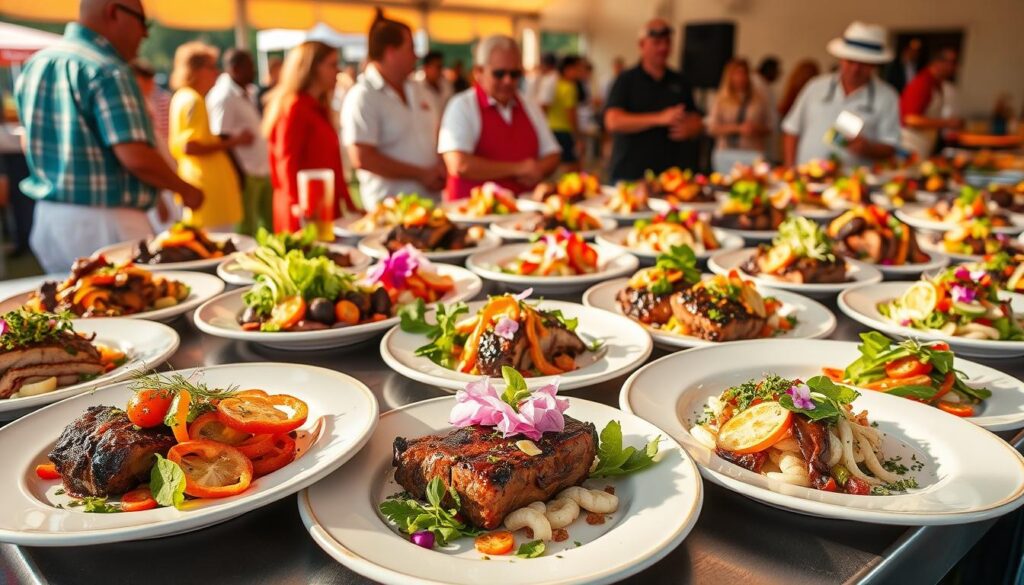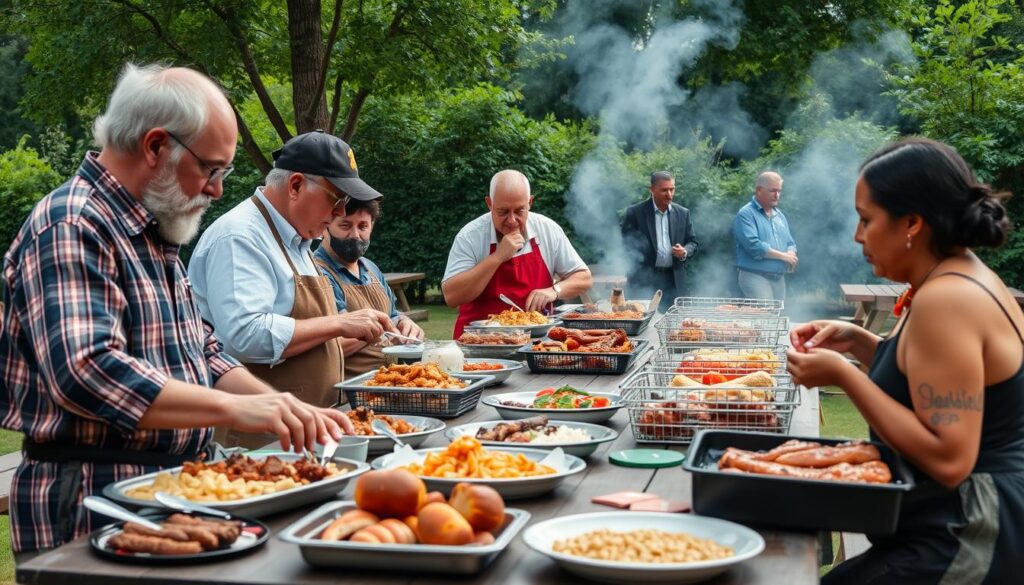Understanding BBQ Competition Judging Criteria: What Judges Look For
Are you ready to improve your BBQ skills and enter the competitive BBQ world? To win the grand champion title, you must know what judges look for. They check everything from the perfect smoke ring to how tender the meat is. The competition is tough, and the standards are high.
What secrets do judges know that can help your BBQ stand out? Let’s explore competitive BBQ judging and find out what makes your dishes win or lose.
Key Takeaways
- Discover the key criteria that BBQ competition judges use to evaluate meat dishes.
- Learn about the importance of appearance, taste, and tenderness in achieving high scores.
- Explore the unique techniques and methods that competitors must master to win big.
- Understand the role of smoke rings, seasoning profiles, and sauce selection in impressing the judges.
- Gain insights into the judging process, from preliminary tastings to the final round.
Insider Perspective: Certified BBQ Judge Shares Insights
Becoming a certified KCBS judge is tough. The judging certification process is long and thorough. It’s run by the top group for competitive barbecue. Here, we’ll look at a barbecue competition insider‘s journey to get this top honor.
Personal Certification Journey
Getting KCBS certification takes hard work and a big love for competitive competitive BBQ experience. Sarah, a big fan of the BBQ scene, tells her story:
“The BBQ judge training was tough but opened my eyes. I learned about flavors, meat doneness, and how to present things fairly. It showed how much I love this community.”
Introduction to Kansas City Barbecue Society (KCBS)
The Kansas City Barbecue Society leads in competitive barbecue. They set the rules for judging and organizing BBQ events across the U.S. Their KCBS certification program makes sure judges can spot the best smoked meats and sides.
Learning to taste without seeing the food and knowing about different meats is key. Being a KCBS-certified judge shows you’re serious about BBQ. It’s a sign of your dedication to the sport’s integrity and excellence.
BBQ Competition Categories and Judging Criteria
Are you a BBQ enthusiast who loves the competition thrill? Ever wondered what judges look for in your BBQ dishes? The Kansas City Barbecue Society (KCBS) runs contests focusing on four main meats: chicken, pork, pork ribs, and beef brisket. Knowing what judges want in each category is key to improving your BBQ skills and winning over the judges.
In chicken contests, judges want a bird that’s juicy, tender, and full of flavor. It should look appealing, with skin that’s crispy and golden. For pork, the meat must be tender, moist, and taste amazing, making every bite melt in your mouth.
- For pork ribs, judges check the meat’s texture and flavor, making sure it’s tender and tasty.
- And with beef brisket, the goal is a mix of tenderness, juiciness, and that smoky flavor that makes BBQ great.
Mastering BBQ competition judging is tough, but possible with hard work, creativity, and knowing each meat’s subtleties. So, step up your game, challenge yourself, and show the judges what you’re capable of!
“The true test of a BBQ master is not just the quality of the meat, but the ability to consistently deliver perfection across all categories.”
Judging Process: From Preliminary to Finals
The BBQ competition judging process is detailed and fair. It begins with the preliminary round. Here, a panel of skilled judges taste and score each entry without knowing who made it. This blind tasting removes bias, letting judges judge solely on the BBQ’s quality.
Entries that do well in the preliminary round move on to the final round. Here, new judges evaluate the top BBQs with a fresh eye. They help pick the best BBQ champions.
Blind Tasting and Scoring System
Blind tasting is key in the judging process. Judges taste samples without knowing who made them. They score each one from 1 to 9, with 9 being the best. They look at appearance, taste, and texture.
Role of Table Captains and Monitors
Table captains and monitors keep the judging smooth. They make sure judges have what they need and keep the tasting blind. Monitors watch over the whole competition. They make sure the rules are followed and scores are fair across all tables.
| Judging Process | Description |
|---|---|
| Preliminary Round | Blind tasting and scoring by a panel of experienced judges |
| Final Round | New judges evaluate the top-scoring entries from the preliminary round |
| Scoring System | 1-9 scale, with 9 being the highest score, based on appearance, taste, and texture |
| Table Captains | Manage the flow of samples and maintain the integrity of the blind tasting |
| Judging Monitors | Oversee the entire competition, enforce rules, and ensure scoring consistency |
BBQ competition judging criteria
In BBQ competitions, how your dish looks, tastes, and smells is key to winning. As a BBQ fan, knowing what judges look for can help you make better dishes.
Evaluating Appearance and Presentation
The first thing judges notice is how your BBQ looks. They check the BBQ appearance judging and presentation assessment. They look for:
- How big the portion is and how it looks
- If the meat is properly trimmed and prepared
- If the garnishes and sides look good
- If everything is clean and well-done
A BBQ that looks great can make a big impression. It can make the judges excited to taste it, helping you stand out.
Assessing Taste and Flavor Profiles
Looks are important, but the real test is in the taste. Judges use their senses to check the taste evaluation and flavor profiles. They look for:
- If the meat is tender and cooked right
- If the seasonings and rubs are balanced
- If the flavors work well together
- If it fits the category’s taste
A great BBQ should have flavors that work well together. Each part should add to the overall taste for a memorable dish.
“The true mark of a champion BBQ is not just about the visual appeal, but the delicate balance of flavors that captivates the palate.”
Knowing what judges look for in looks and taste can help you improve your BBQ skills. This can lead you to make dishes that impress judges and win BBQ competitions.
Mastering the Art of Meat Tenderness
Getting the meat just right is key in BBQ competitions. Judges want it to be moist and juicy, with just the right feel. Knowing the best doneness levels for each meat is crucial.
Doneness Levels for Different Meats
The tenderness of brisket, pork ribs, and chicken can make or break your BBQ. Here’s what judges look for in perfect doneness:
- Brisket: Judges want brisket that’s tender but still has some bite. It should be moist and juicy, with a slight pull when bitten into.
- Pork Ribs: Ribs should be tender enough to pull cleanly from the bone. They should have a slight chew and a rich flavor.
- Chicken: Chicken should be juicy and tender, without being dry or rubbery. This is the doneness judges look for.
Knowing the ins and outs of BBQ meat tenderness and doneness levels can take your dishes to the next level. It will impress even the toughest judges.
Strange Rules: Garnish Dos and Don’ts
In BBQ competitions, the rules for garnishes can be quite surprising. Some greens like curly kale and parsley are okay, but many others are not. Judges focus on the meat’s taste and tenderness, not the garnish’s look.
Knowing the BBQ competition garnish rules is key to winning. It’s important to know which legal garnishes you can use and which prohibited garnishes to avoid. The way you present your garnish can greatly affect how the judges see your dish.
Permitted Garnishes
- Curly kale
- Parsley
- Cilantro
- Green onions
Prohibited Garnishes
- Lettuce
- Spinach
- Basil
- Arugula
BBQ competitors should learn the garnish presentation rules from groups like the Kansas City Barbecue Society (KCBS). Following these rules can help impress judges and win a top spot.

“The garnish itself is not judged, but it needs to be appropriate and not detract from the meat.”
| Permitted Garnishes | Prohibited Garnishes |
|---|---|
| Curly kale, Parsley, Cilantro, Green onions | Lettuce, Spinach, Basil, Arugula |
Judging Beyond Meats: Beans and Chili
At BBQ competitions, the main meats often get the most attention. But, many events also judge beans and chili as “ancillary” side dishes. These dishes are judged like the main meats, with judges looking at aroma, appearance, texture, and taste.
Scoring Criteria for Side Dishes
When judging BBQ competition side dishes like beans and chili, the scoring is strict. Judges follow detailed guidelines to evaluate these items:
- Aroma: The dish should have a balanced, inviting smell. No strong or bad smells are allowed.
- Appearance: The dish must look good and appetizing.
- Texture: The side dish should feel good in your mouth. It should not be too soft, mushy, or crunchy.
- Taste: The flavor profile of the beans or chili is crucial. Judges look for a mix of seasonings that leaves a lasting impression.
Even though ancillary categories like beans and chili might not get as much attention as the main meats, they’re still key to the competition. Making great side dishes can really help competitors stand out in this tough competition.
Ethics and Integrity in BBQ Judging
In competitive BBQ, keeping high ethics and integrity is key. As a judge, you must give fair and unbiased scores. This means you can’t have personal ties with the contestants.
Judges follow a strict ethics code. They avoid any conflicts of interest and keep competition info secret. They don’t share scores or results with others.
Being impartial is crucial. Judges look at each dish on its own, not swayed by outside factors. They need a sharp eye for detail and a deep BBQ knowledge. They give honest feedback to help competitors improve.
By sticking to these ethics, judges make sure the winners are truly the best. This keeps the sport honest and motivates new BBQ lovers to aim high.
“The true mark of a great BBQ judge is not the number of competitions they’ve attended, but the unwavering commitment to fairness and integrity that they bring to each and every event.”
As a judge, you decide the competition’s outcome. Use your power with care, professionalism, and a deep love for BBQ.

Tips for Aspiring BBQ Judges
If you love competitive barbecue and want to be a certified judge, there’s a lot to learn. Becoming a BBQ judge is rewarding. You’ll appreciate the art and science of making championship ‘cue even more.
Understanding Judging Responsibilities
Being a BBQ judge means you need to be detail-oriented, have a taste for adventure, and keep the competition fair. You’ll learn about judging criteria and the blind tasting process. It’s a tough but rewarding journey.
- Learn the Kansas City Barbecue Society (KCBS) rules for judging meats like ribs and brisket.
- Go to judge training sessions to improve your senses and score meats accurately.
- Join local BBQ events to watch and learn from experienced judges.
- Enjoy the BBQ community’s friendly vibe. Seasoned judges often share their knowledge and support new ones.
By diving into competitive barbecue and learning about judge duties, you’ll make a big impact in this exciting food world.
“The best judges know a lot about barbecue science and art. They also love the craft. Their fairness and integrity make them key to the community.”
Conclusion
Mastering BBQ competition judging is key for any serious pitmaster aiming for the top prize. Knowing what judges look for in appearance, taste, and tenderness can improve your winning BBQ techniques and recipes. This guide has given you a deep dive into the judging process. Now, you’re ready to master the BBQ judging criteria and boost your BBQ skills.
The tips on judging criteria, scoring, and best can change how you approach BBQ competitions. They’re useful whether you’re a pro or new to the game. Using these tips can sharpen your skills, improve your presentation, and help you win the Grand Champion title.
Success in BBQ isn’t just about winning. It’s about your dedication, passion, and always getting better. Keep working on your skills, trying new flavors, and keeping high standards in BBQ competitions. With this attitude, you’ll be a top contender in the BBQ world and gain respect from peers and judges.

Leave a Reply